Breezy, light-blocking, richly textured, or tech-savvy—today’s dining-room curtains do far more than frame a window. Designers in 2025 are leaning into layered sheers, retro prints, luxe fabrics, clever pelmets, and even motorized tracks to tailor privacy, acoustics, and ambience with style. Drawing on the latest fabric reports, trend forecasts, and expert tips, the 20 ideas below show how to dress any dining space—large or small, formal or relaxed—with curtains that feel purposeful and fresh. From airy linen to shimmering metallics, each suggestion pinpoints a distinct benefit, helping you match function to mood while staying squarely on-trend.
1. Airy Linen Sheer Dining Room Curtains
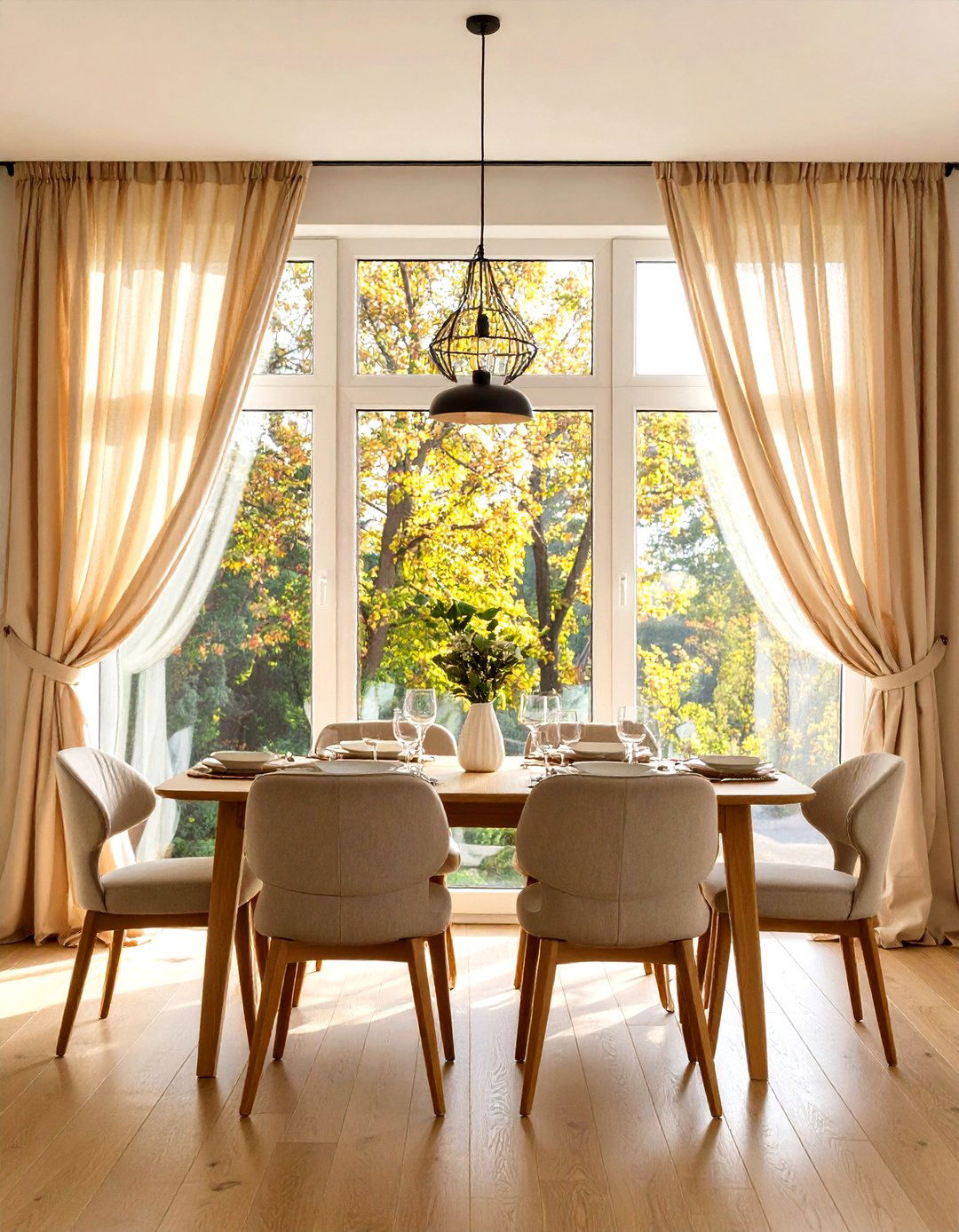
A gentle billow of linen sheers lets daylight wash across the table while keeping glare in check. Designers rate linen among the best fabrics for eating areas because it breathes, drapes beautifully, and softens acoustics without trapping kitchen odors. TWOPAGES Curtains Homes & Gardens Homes & Gardens Hang panels a few inches above the window to emphasize height and puddle them lightly on the floor for relaxed elegance. The gauzy weave filters harsh midday light yet preserves an open, sociable feel—perfect for long lunches or board-game nights. For evening intimacy, layer slim blackout rollers behind the sheers so you can fine-tune privacy without sacrificing linen’s casual charm.
2. Retro Pattern Dining Room Curtain Panels
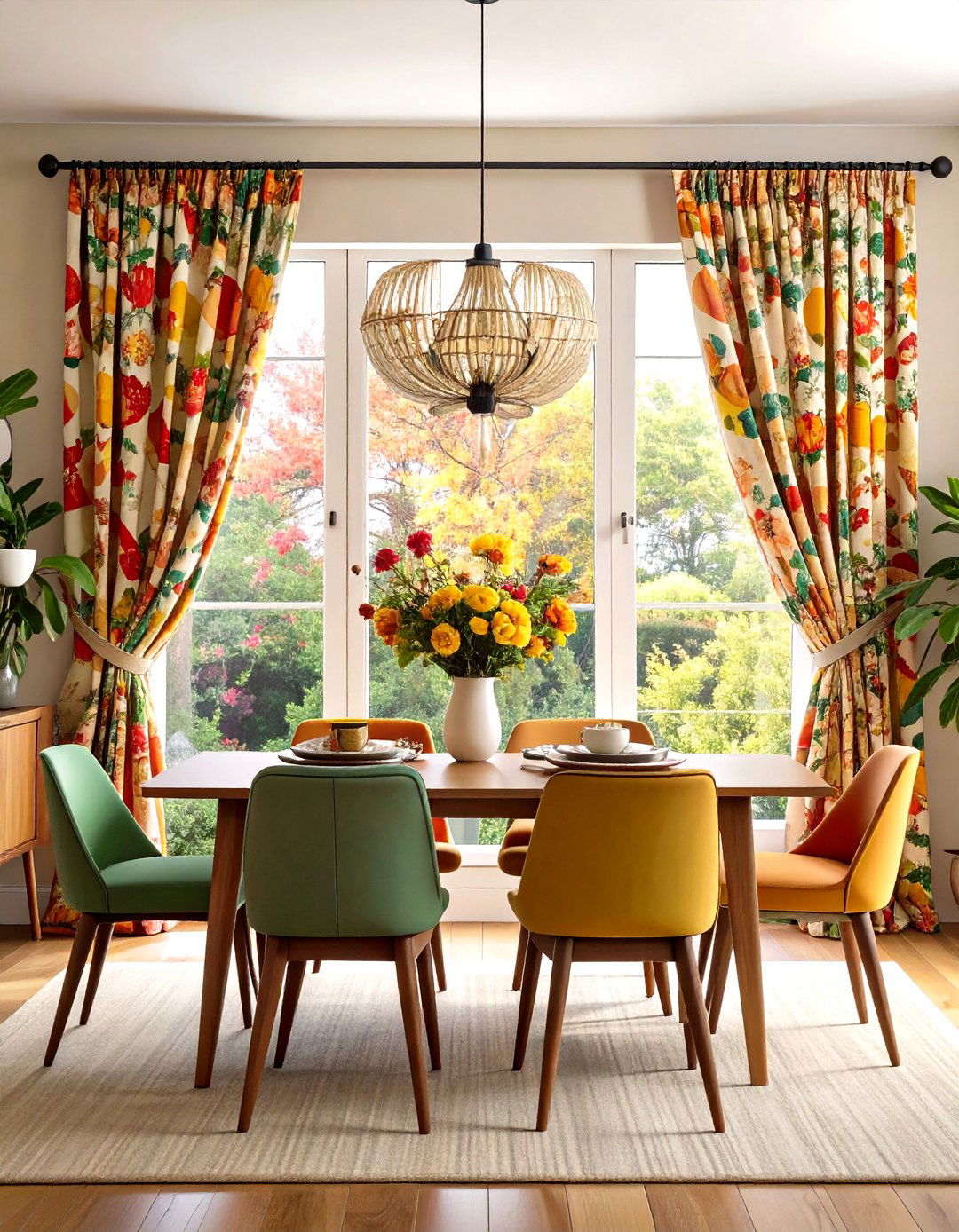
Bold ’70s geometrics and ditsy florals are enjoying a comeback, injecting character into otherwise neutral dining suites. Homes & Gardens Homes & Gardens Choose a single saturated hue from your tableware and echo it in a repeat pattern to unify the room. Pair wide retro prints with streamlined modern furniture to keep the look intentional, not kitsch. If full-length panels feel loud, use the fabric just on tiebacks or a contrasting leading edge so guests glimpse the motif without feeling overwhelmed. Patterned curtains also disguise the occasional splash of sauce, making them as practical as they are punchy.
3. Floor-to-Ceiling Dining Room Drapes
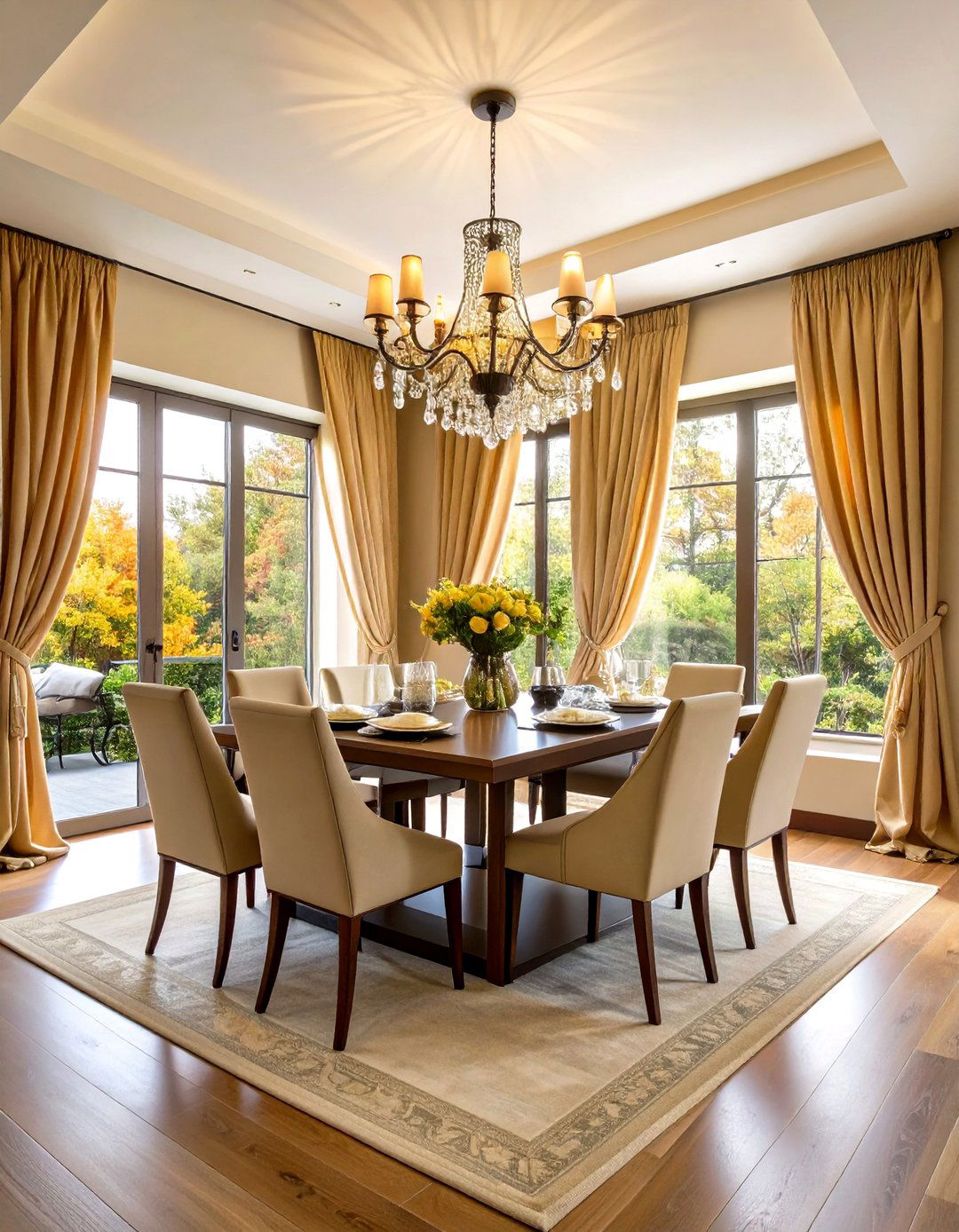
Running curtains from ceiling track to skimming floor instantly elongates walls, making even modest dining nooks look grander. Barn & Willow Livingetc Extra-long drops add a layer of thermal insulation and hush echoing chatter during busy dinners. Opt for sturdy cotton-linen blends that pool gently for drama, or micro-pleated synthetics if you prefer a crisp, hotel-like break. When mounting, extend rods eight inches past each side of the frame so panels can stack off the glass; you’ll gain light while keeping the illusion of a taller window intact.
4. Layered Dining Room Curtains with Sheers and Blackouts
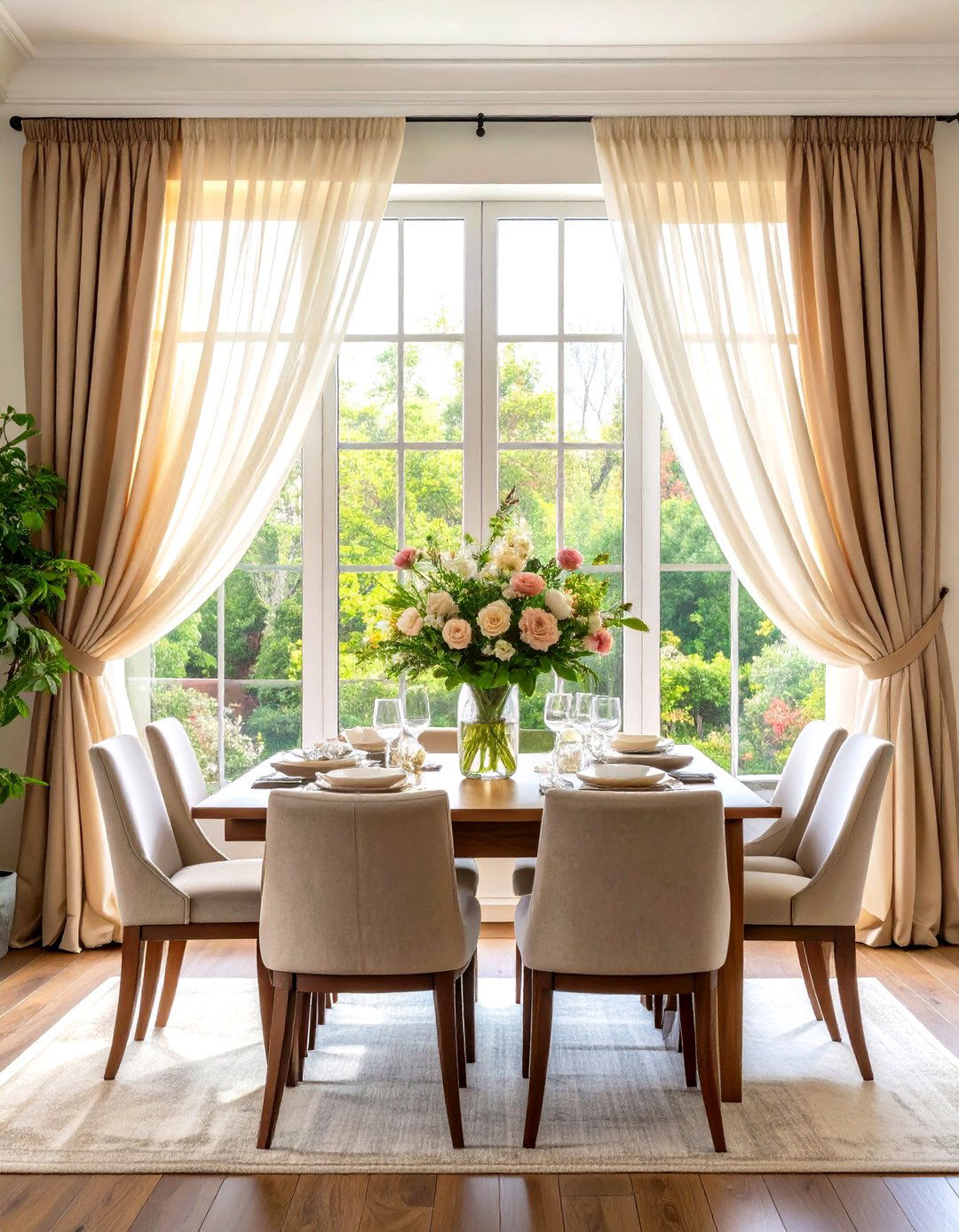
Combining lightweight sheers with heavier drapes gives you dial-able control of light and privacy—let sun stream through voile at brunch, then draw plush panels for candlelit suppers. The Shade Store Homes & Gardens Designers advise matching the sheer’s color to your wall for softness, while choosing a contrasting drape to anchor the scheme. A double rod keeps hardware neat; if space is tight, mount a discreet recessed track for each layer. The result: a tailored, multidimensional window treatment that feels bespoke yet forgiving when dining schedules—and seasons—shift.
5. Charming Café Dining Room Curtains

Mounted halfway up the window, café curtains deliver privacy exactly where you need it while letting the upper sash flood the room with daylight. Southern Living Country Living Homes & Gardens Linen plaid or ticking stripes lend nostalgic, bistro flair without veering rustic. Use slender brass tension rods to echo cutlery finishes and make panels easy to whisk off for laundering. In an open-plan layout, café curtains also frame buffet servers or built-in benches without blocking sightlines, encouraging guests to linger.
6. Color-Drenched Two-Tone Dining Room Drapes
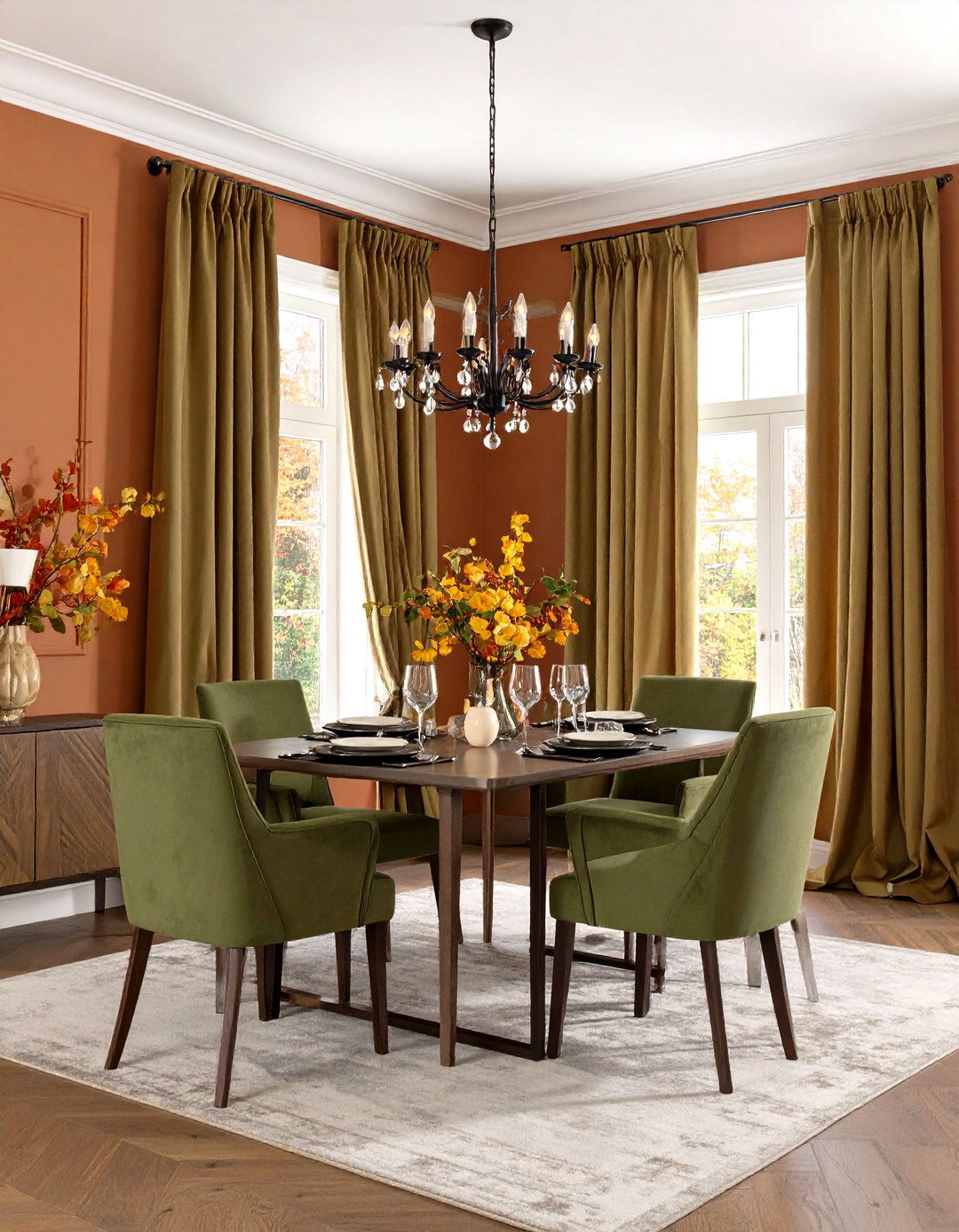
Painting walls, trim, and curtains in tonal blocks of one hue creates a cocooning, design-forward statement known as color drenching. Martha Stewart Homes & Gardens For balance, choose a lighter shade for upper curtain thirds and a deeper value below the chair rail, or vice versa. The eye travels vertically, exaggerating ceiling height and spotlighting architectural moldings. Finish seams with invisible tape rather than visible stitching to keep the gradient seamless. Because fabric surrounds the table, pick a hue that flatters food—soft terracotta or olive green lend warmth without distorting plate colors.
7. Velvet Dining Room Curtains for Quiet Luxury
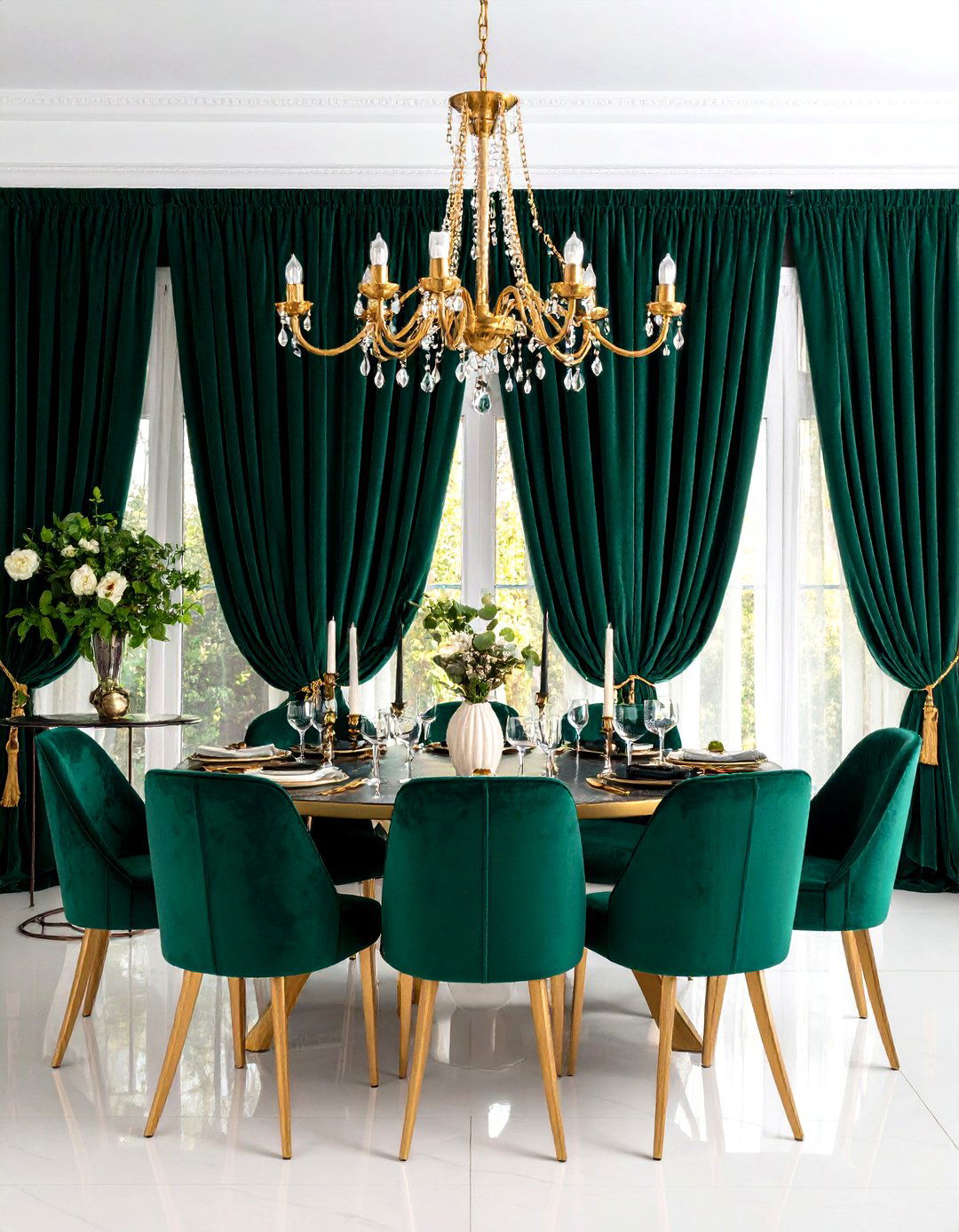
Plush velvet instantly mutes noise and ups the formality factor—ideal for echo-prone rooms or celebratory dinners. The Fabric Mill Livingetc Designers recommend cotton or recycled-poly velvet for easier spot cleaning than silk. Deep jewel tones absorb excess daylight, allowing dimmable pendants to glow. Line panels with blackout fabric to prevent fading and give folds a sumptuous structure. When styling, let the velvet just “kiss” the floor; heavy pooling can collect dust in high-traffic dining zones.
8. Ombre Dining Room Curtain Panels

A subtle gradient that fades from dark hem to pale header (or vice versa) adds movement without committing to busy prints. Pinterest Pinterest Dip-dye linen sheers offer a casual coastal feel, while digitally printed polyester blends achieve softer transitions in modern schemes. Keep table linens solid so the fade remains the star. For a cohesive vignette, match the deepest ombre shade to artwork or chair upholstery, tying the palette together with minimal effort.
9. Textured Natural-Fiber Dining Room Curtains
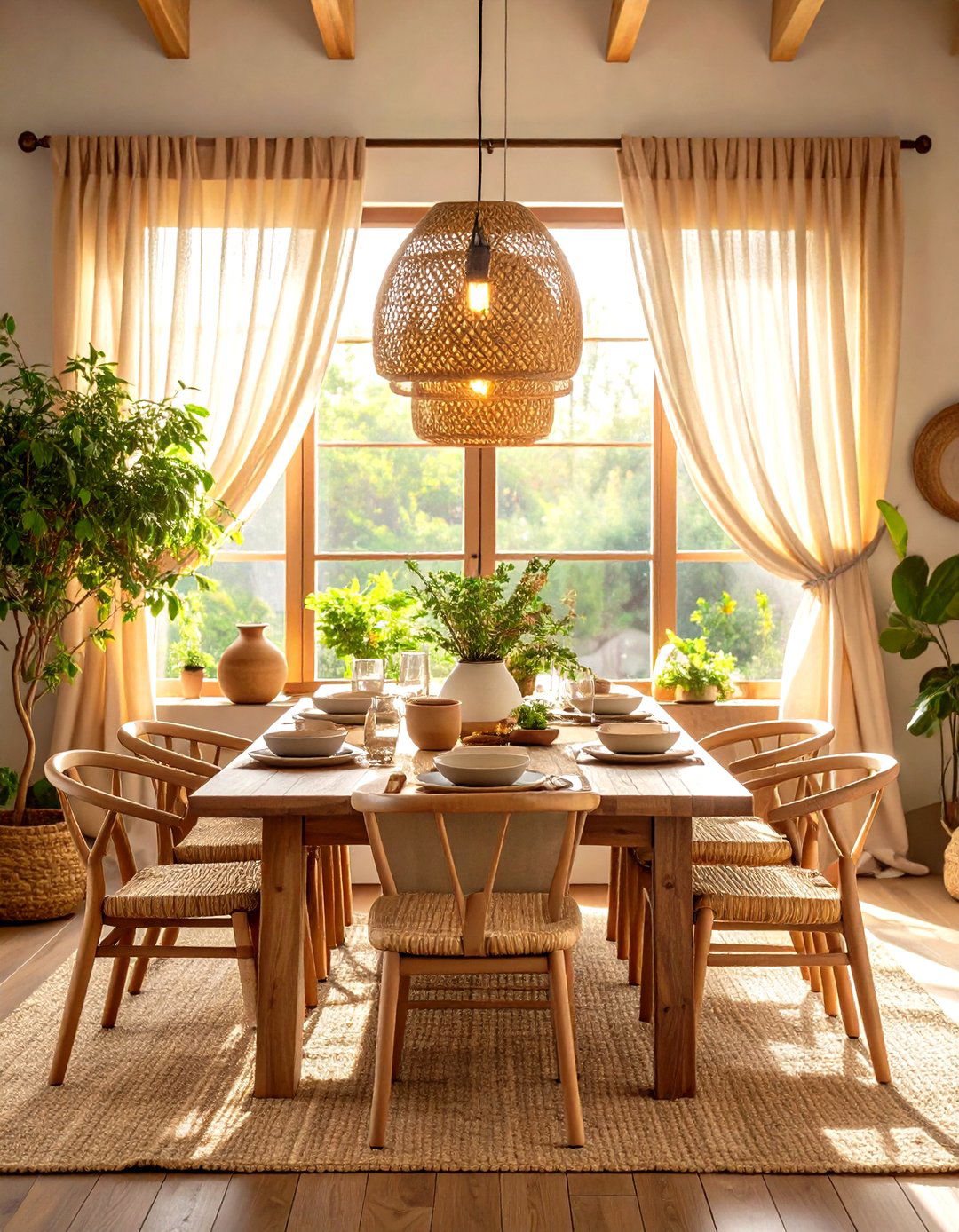
Raw weaves like bamboo, jute, or heavyweight linen spotlight sustainability and tactility—two pillars of 2025 design. The Fabric Mill Homes & Gardens Their slubbed surfaces diffuse glare into a golden glow that flatters skin tones at the table. Because coarse fibers can appear casual, add pinch-pleated headers or a crisp ironed edge to elevate them. Organic textures also pair beautifully with rattan pendant lights and earthenware serving pieces, reinforcing a farm-to-table ethos.
10. Dining Room Curtains with Statement Pelmets
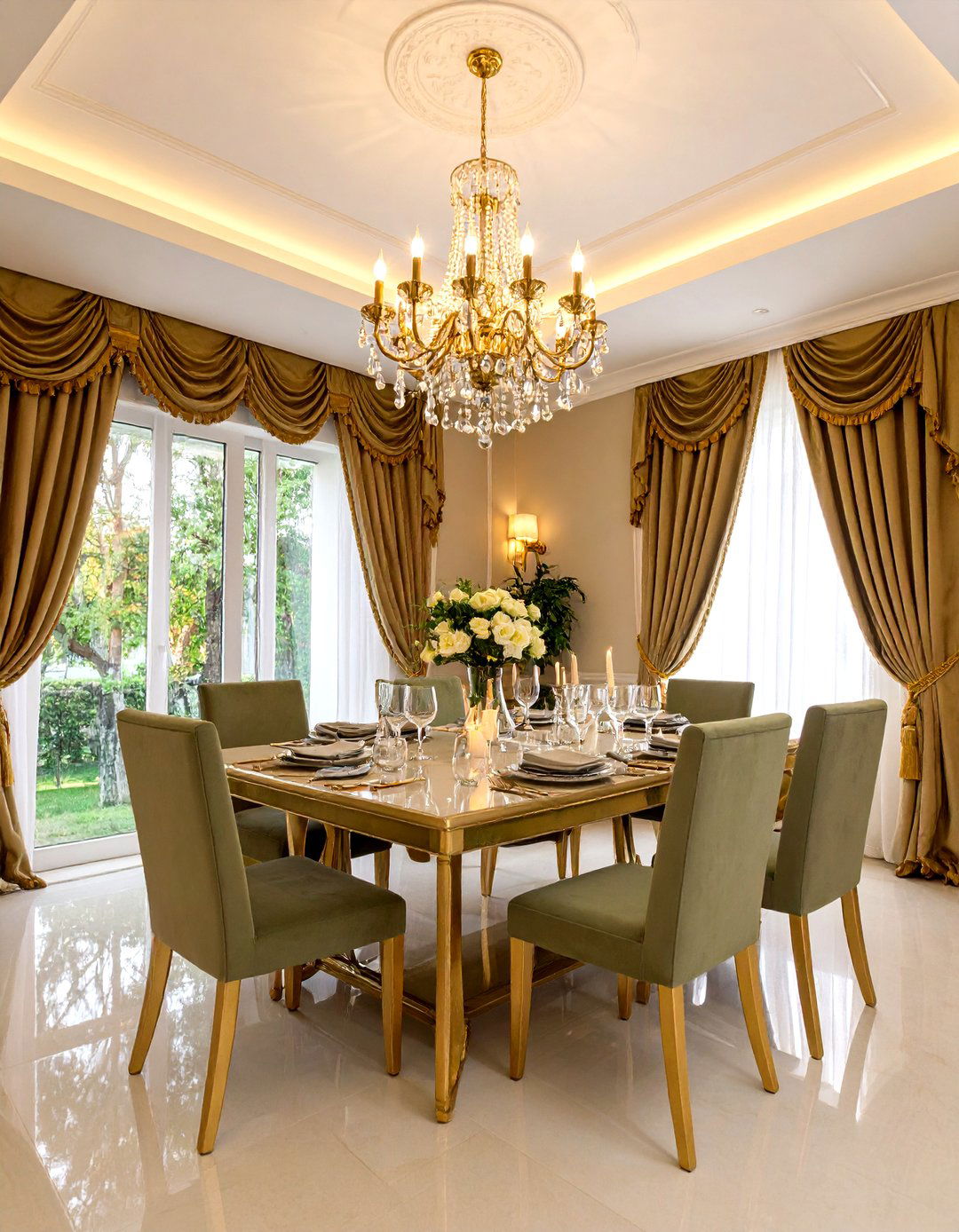
A boldly upholstered pelmet or cornice hides tracks, blocks drafts, and delivers tailored polish reminiscent of grand hotels. Homes & Gardens MELANIE LISSACK INTERIORS Homes & Gardens Choose a fabric that contrasts subtly with the drapes—think velvet pelmet over linen panels—to add dimension. Box pelmets can be filled with lightweight insulation, reducing heat loss through older windows. When ceiling height is limited, install the pelmet flush with the cornice molding to elongate the wall visually.
11. Metallic-Accented Dining Room Curtains

Threads of soft gold, champagne, or pewter woven into neutral cloth bounce candlelight around the room, adding gentle glamour without resorting to sequins. Miulee Homes & Gardens Metallics read as a new neutral, pairing effortlessly with warm woods and cool stone tabletops alike. Use muted hardware—brushed brass or matte black rods—to keep the shimmer sophisticated. If full shimmer feels bold, introduce metallic on tiebacks or bottom borders only.
12. Pinch-Pleat Silk Dining Room Drapes

Silk’s natural luster and the crisp rhythm of pinch pleats telegraph formality suited to milestone dinners. A blackout lining prevents UV damage and sharpens folds, while interlining adds thermal heft. Stick to mid-weight dupioni or taffeta so pleats hold shape, and fit curtain hooks precisely to avoid sagging. Pair with a vintage rug and polished flatware to complete an elevated, cohesive look.
13. Botanical-Print Dining Room Curtains
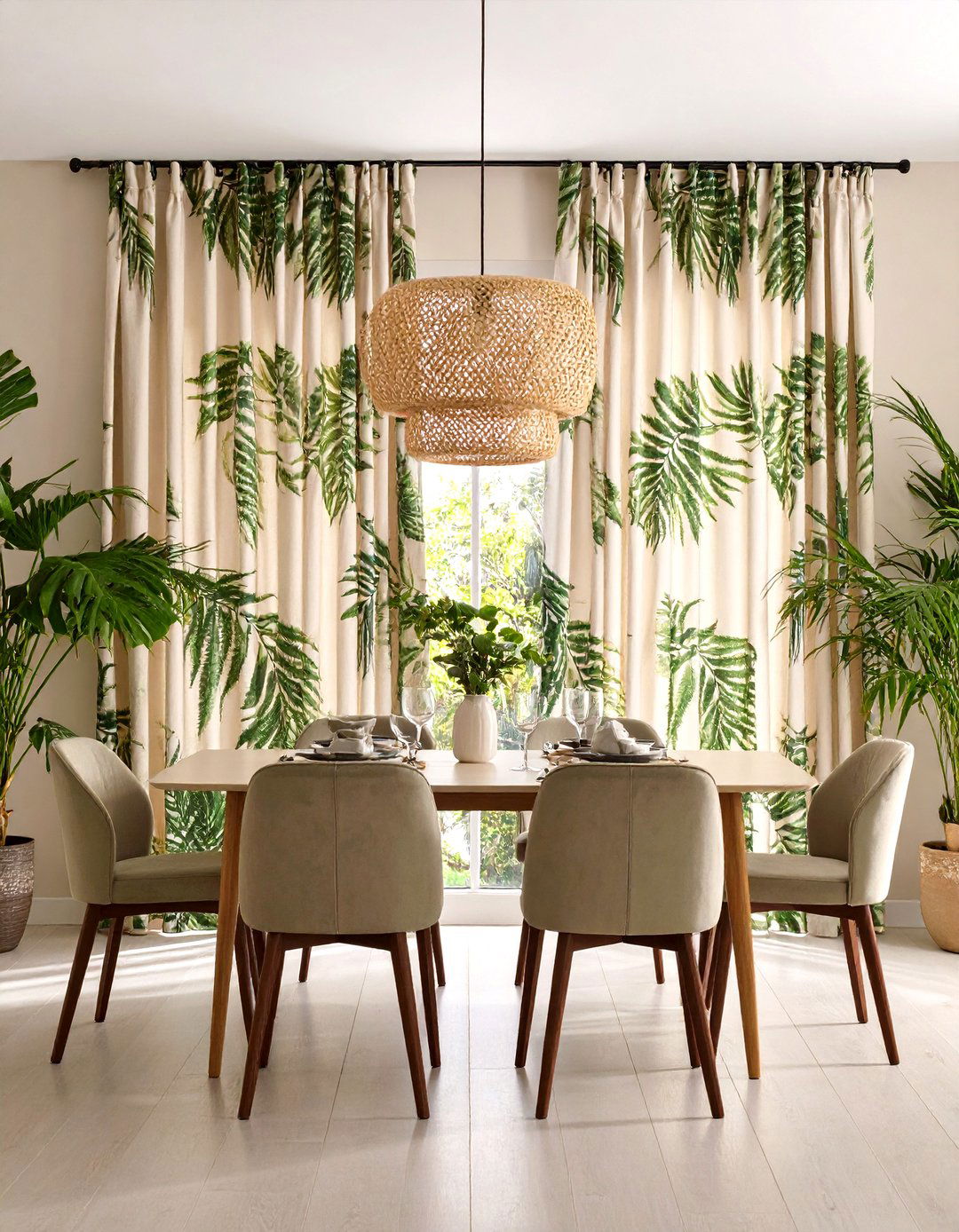
Fern fronds, palm silhouettes, or tiny ditsy blooms lend a lively backdrop that feels current yet timeless. Homes & Gardens Homes & Gardens Homes & Gardens Keep frames slim so the print isn’t pinched, and pick a pattern scale that balances your room—large leaves for airy lofts, petite sprigs for compact breakfast nooks. Botanical motifs echo floral centerpieces, making table styling effortless. A light cotton-linen mix prevents busy prints from overwhelming the space.
14. Tassel-Trimmed Dining Room Curtains
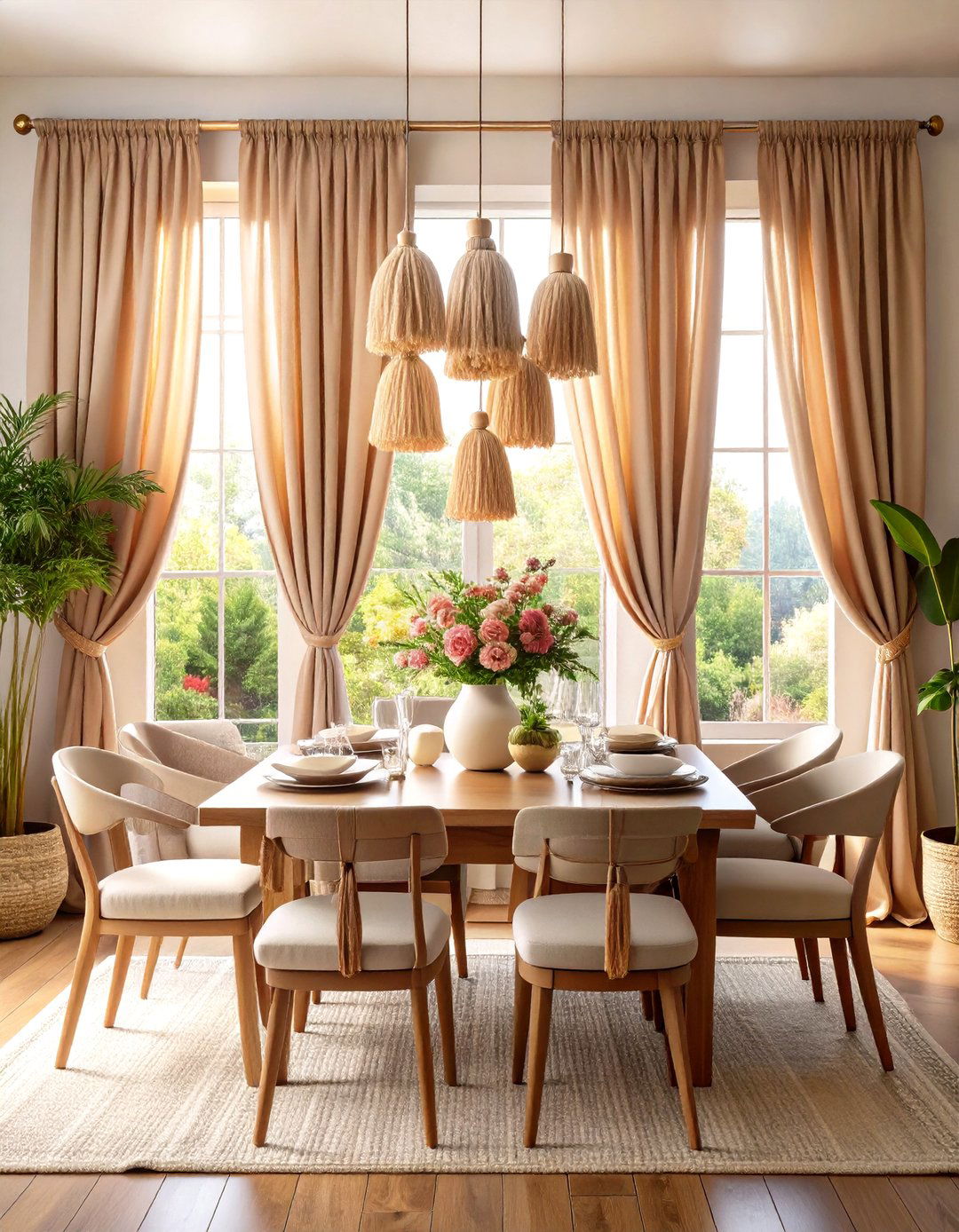
Decorative trims—from cotton pom-poms to braided bullion—are resurging as an easy upgrade to ready-made panels. Homes & Gardens Homes & Gardens Apply tape along lead edges or hems with fabric glue for a no-sew weekend project. Tassels draw the eye vertically, subtly elongating windows while injecting artisanal charm. Stick to one trim style per room to avoid visual clutter, and repeat its color in cloth napkins or chair cushions for cohesion.
15. Roman Shades with Side Dining Room Panels

Mounting crisp Roman shades inside the recess and framing them with stationary side curtains yields depth, insulation, and flexible light control. Spiffy Spools Pinterest The Shade Store Shades block midday glare on diners’ faces, while side panels soften edges and hide light gaps. Choose complementary but not identical fabrics—maybe a woven grasscloth shade with velvet drapes—to layer texture. Because Romans draw upward, they free sill space for candles or serving platters during gatherings.
16. Smart Motorized Dining Room Curtain Tracks

Voice-activated or app-controlled tracks raise hospitality a notch—open drapes hands-free when carrying hot dishes, or schedule closures for energy savings on sunny afternoons. VeilVeil Many systems integrate with mainstream smart-home hubs and operate quietly enough for conversation to continue uninterrupted. Opt for rechargeable battery packs if wiring is tricky in full-height dining rooms. For aesthetics, conceal the motor in a slim fascia painted the wall color.
17. Rustic Burlap-Blend Dining Room Curtains
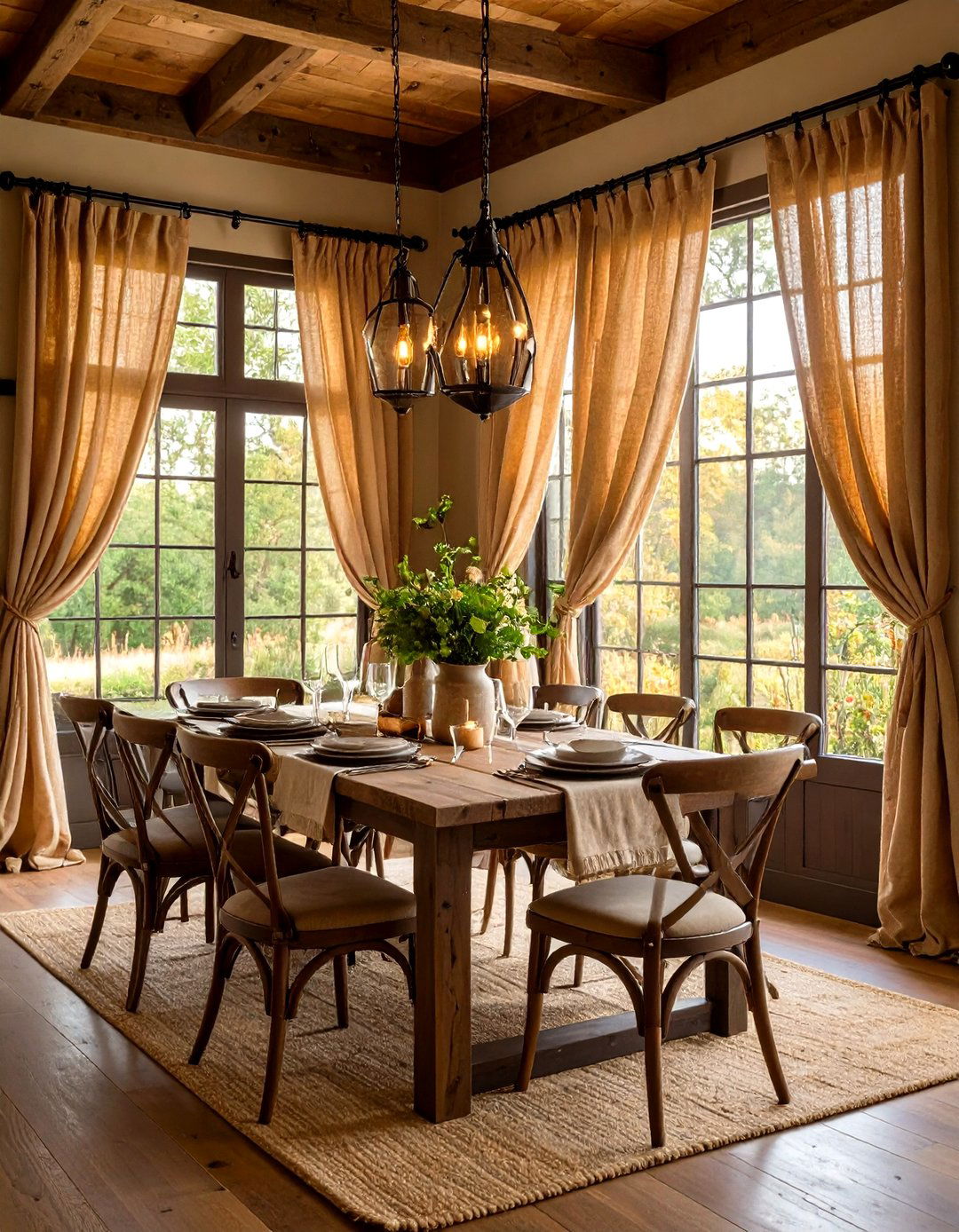
Burlap or coarse-weave linen blends bring farmhouse authenticity, echoing chunky wood tables and galvanized-metal accents. TWOPAGES Curtains Homes & Gardens To keep texture from skewing rough, line panels with ivory cotton and finish edges with ladder-stitched hems. Because burlap can sag in humidity, use clip rings on a sturdy rod so panels remain easy to adjust throughout changing seasons.
18. Pattern-Drenched Dining Room Curtains
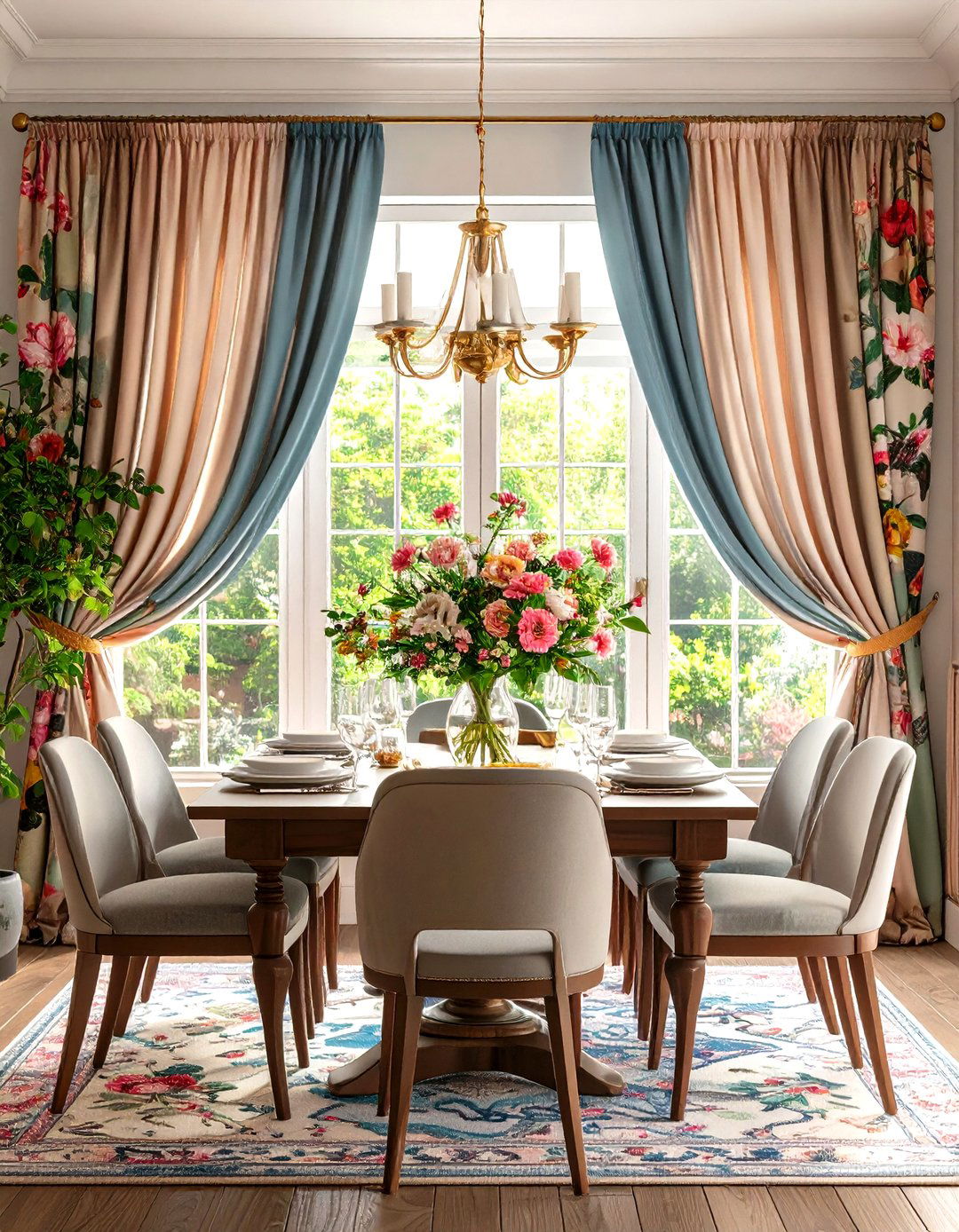
Covering drapes, walls, and sometimes even seating in a single pattern creates immersive drama reminiscent of upscale bistros. Homes & Gardens Martha Stewart Choose a tight, two-color motif (stripes, checks, or micro florals) so the effect feels tailored, not overwhelming. Break continuity with solid seat cushions and metallic chargers to give the eye rest. Ensure pattern repeat aligns across seams for a couture finish that reads intentional, not accidental.
19. Mixed Sheer-and-Solid Dining Room Layers
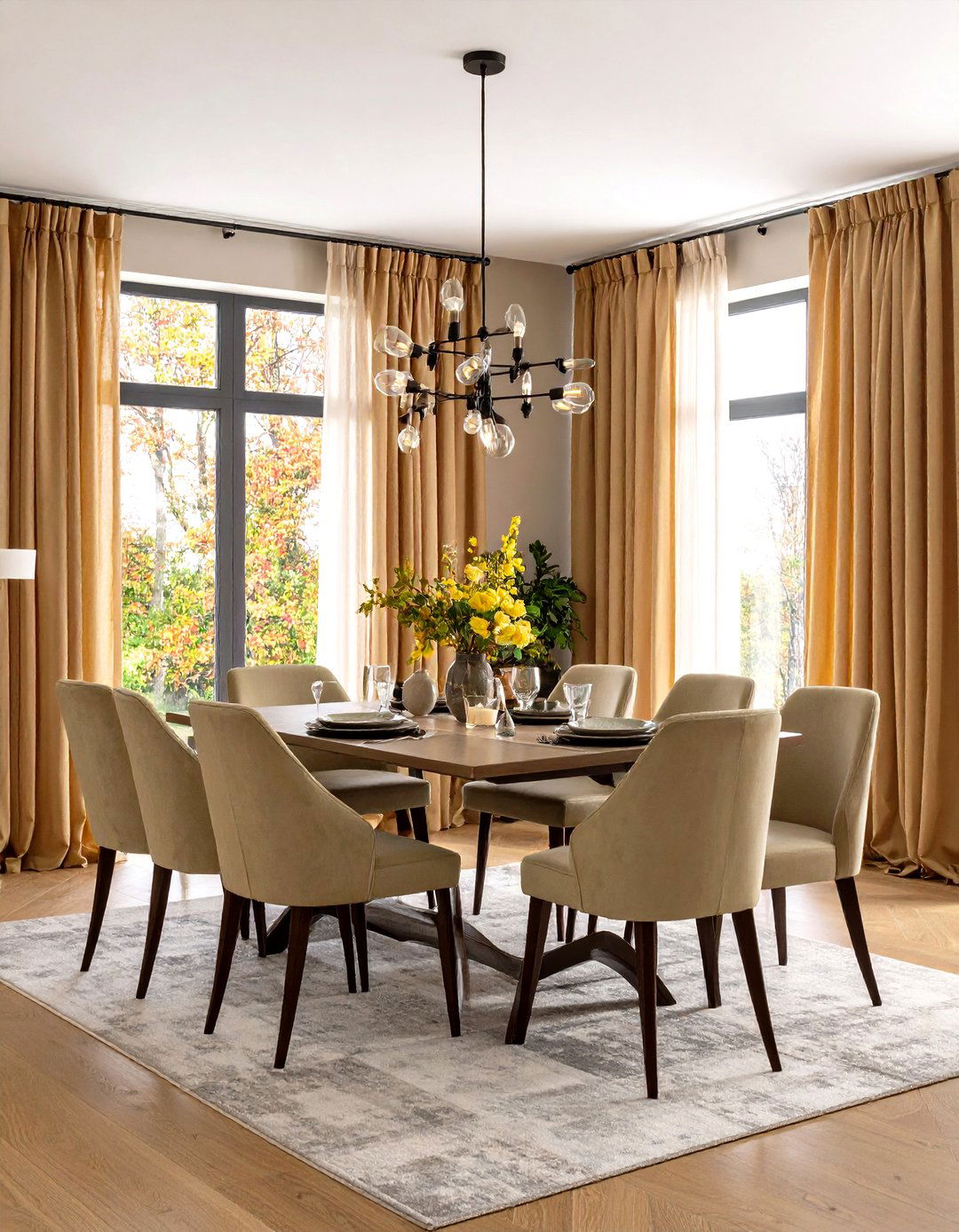
Alternating sheer and opaque panels on a double rod lets you slide fabrics like stage wings—sheers for brunch, solids for after-dinner drinks. The Shade Store Livingetc Use identical header styles so panels glide evenly. Stick to a cohesive palette—think warm oatmeal sheers with taupe linen drapes—to avoid a “patchwork” effect. This setup also works well on bay windows: curve flexible rods along the bay and layer fabrics to hug each angle.
20. Minimalist Ceiling-Track Dining Room Curtains
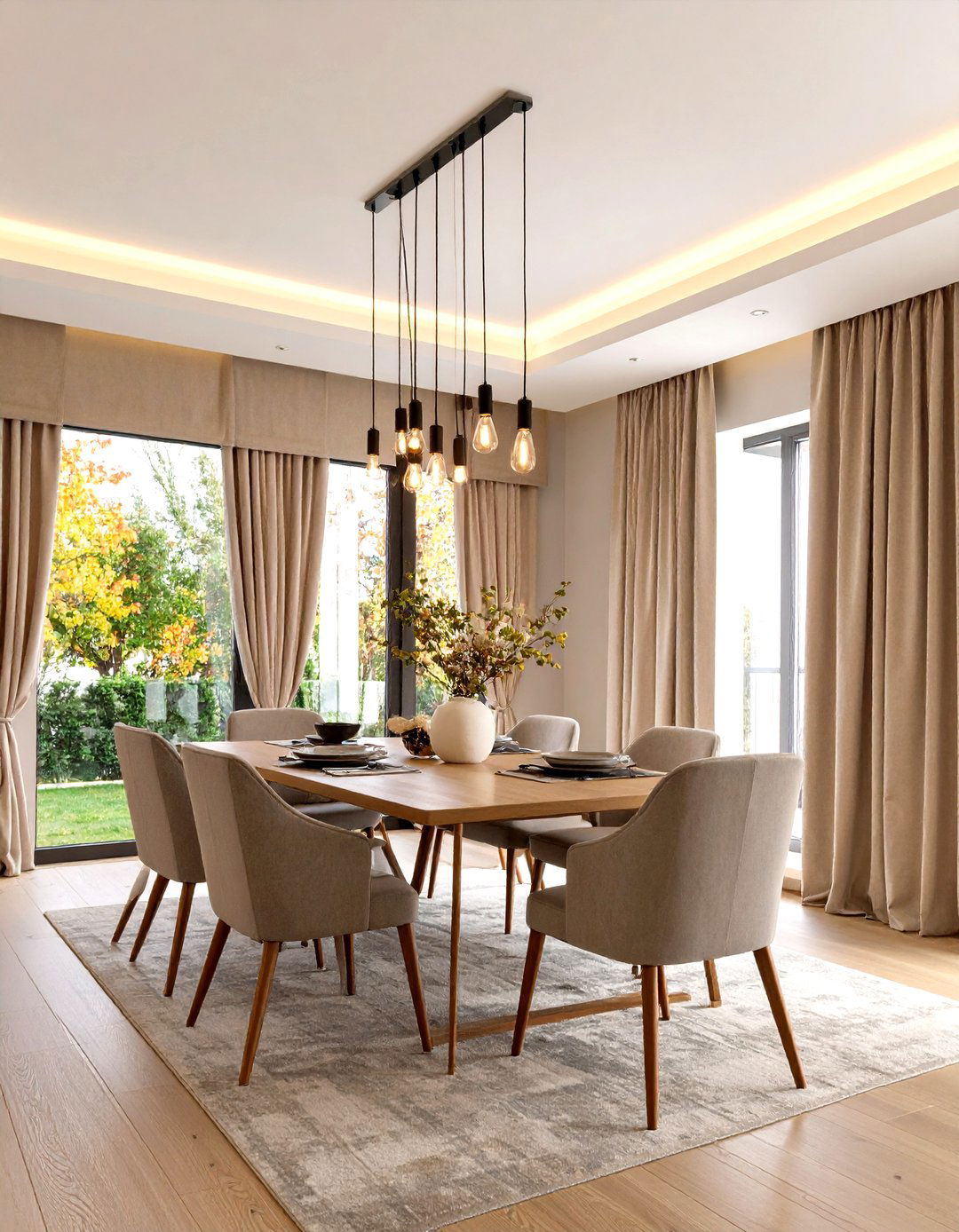
For an ultra-clean aesthetic, install slim recessed tracks that let curtains appear to cascade from the ceiling itself. Livingetc Neutral wool-blend panels in bone, dove, or greige keep focus on architectural lines and statement lighting. The hidden hardware tricks the eye into perceiving higher ceilings and wider expanses of glass—an asset in contemporary open-concept homes. Add weighted hems so fabric falls in sharp, gallery-style columns.
Conclusion:
Whether you crave breezy linen sheers that whisper in the breeze, opulent pinch-pleat silk worthy of a formal fête, or tech-enabled drapes that glide at a voice command, today’s dining-room curtains offer a tailored solution for every style and need. Layering textures, experimenting with prints, embracing smart tracks, and elevating hardware all help transform windows into starring design elements. Pick the idea that resonates with your home’s character, and your dining space will serve up both comfort and conversation for seasons to come.



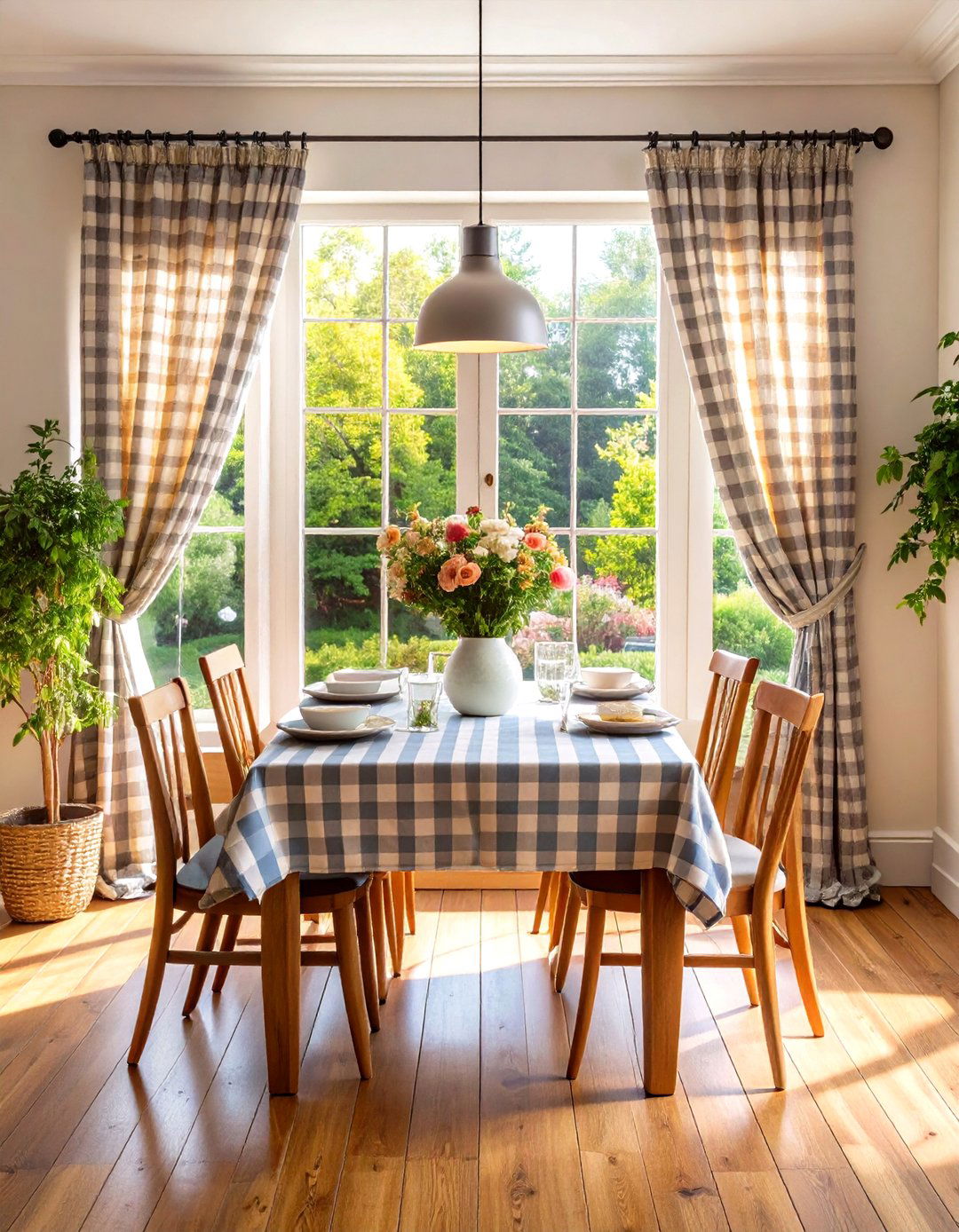

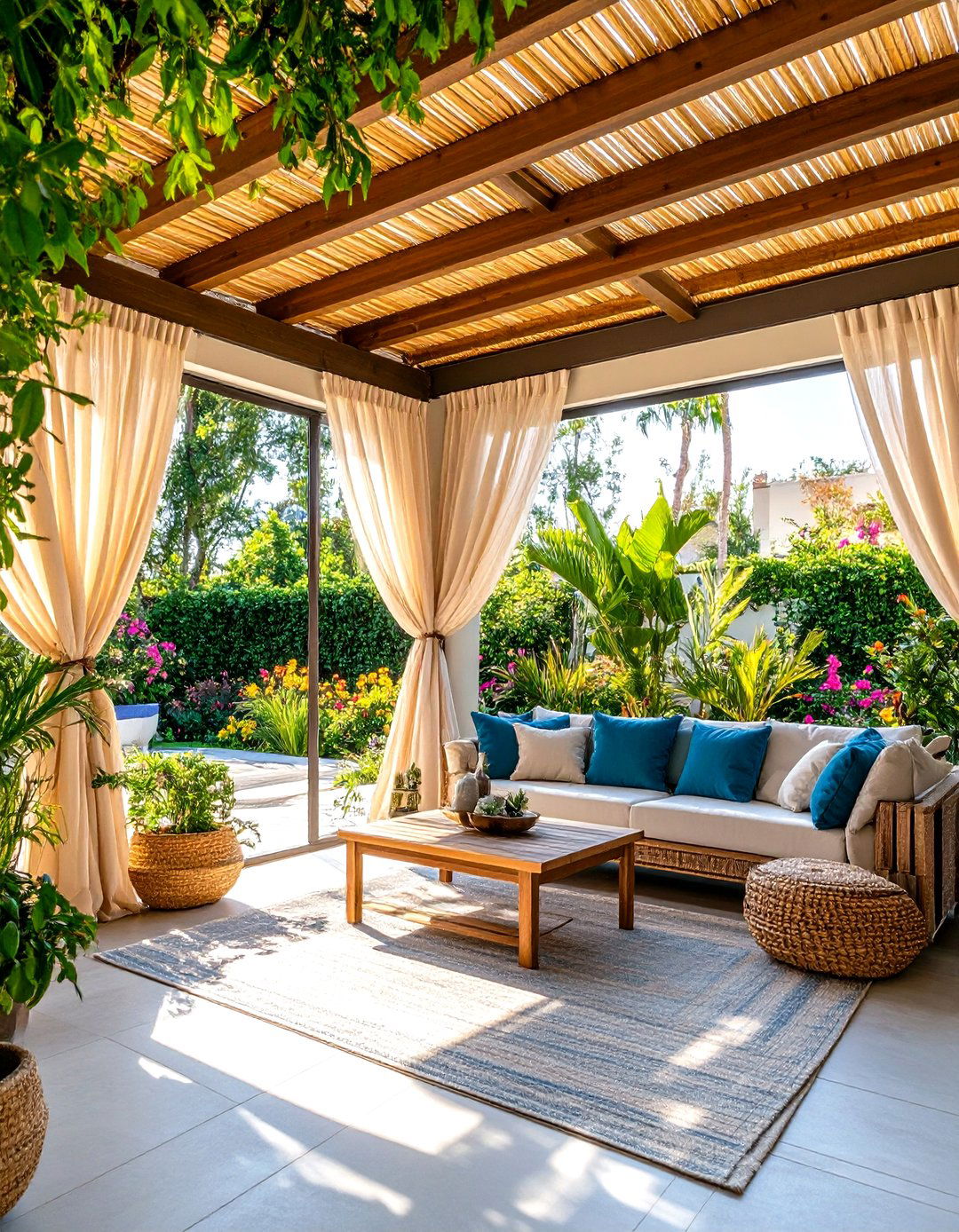
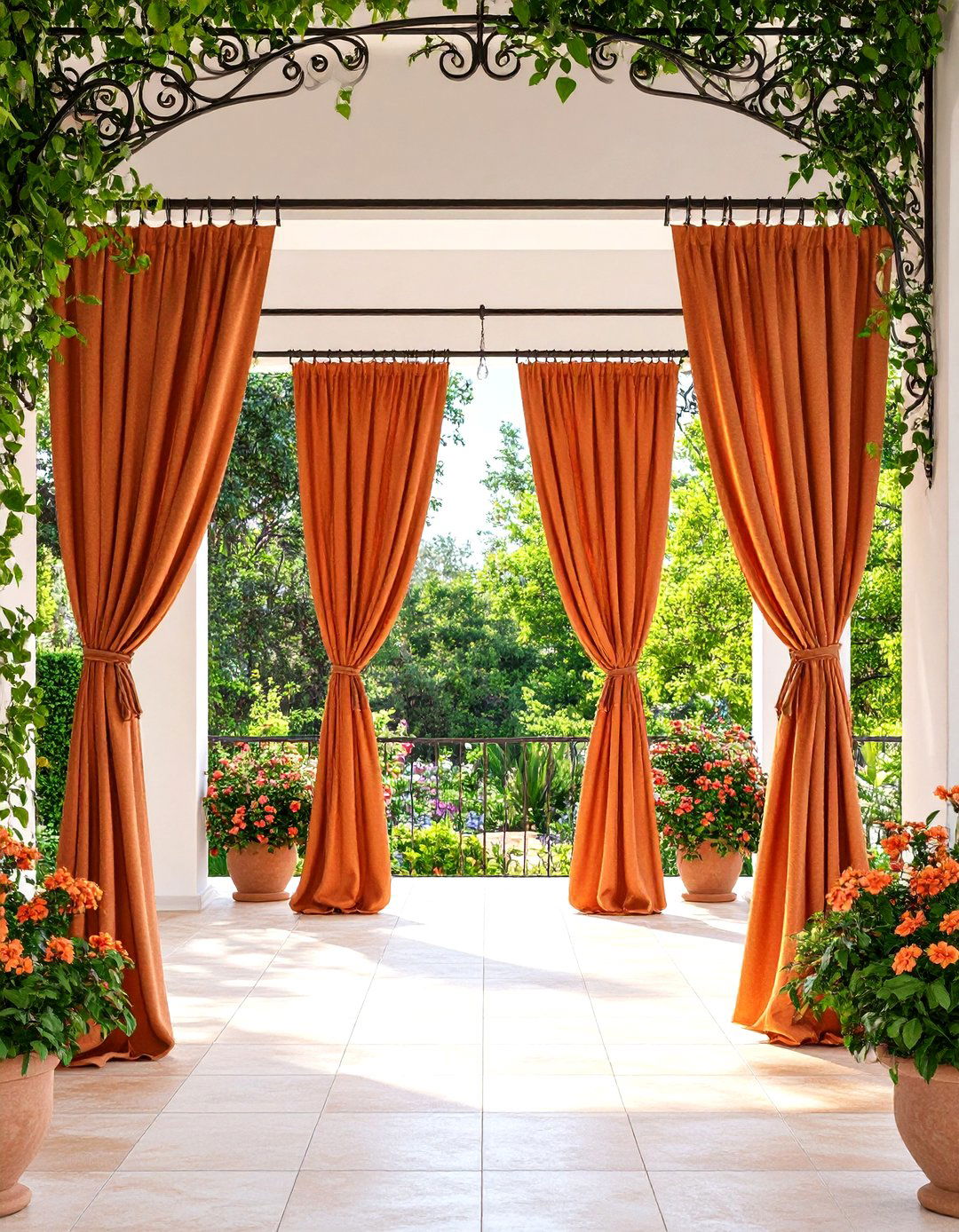
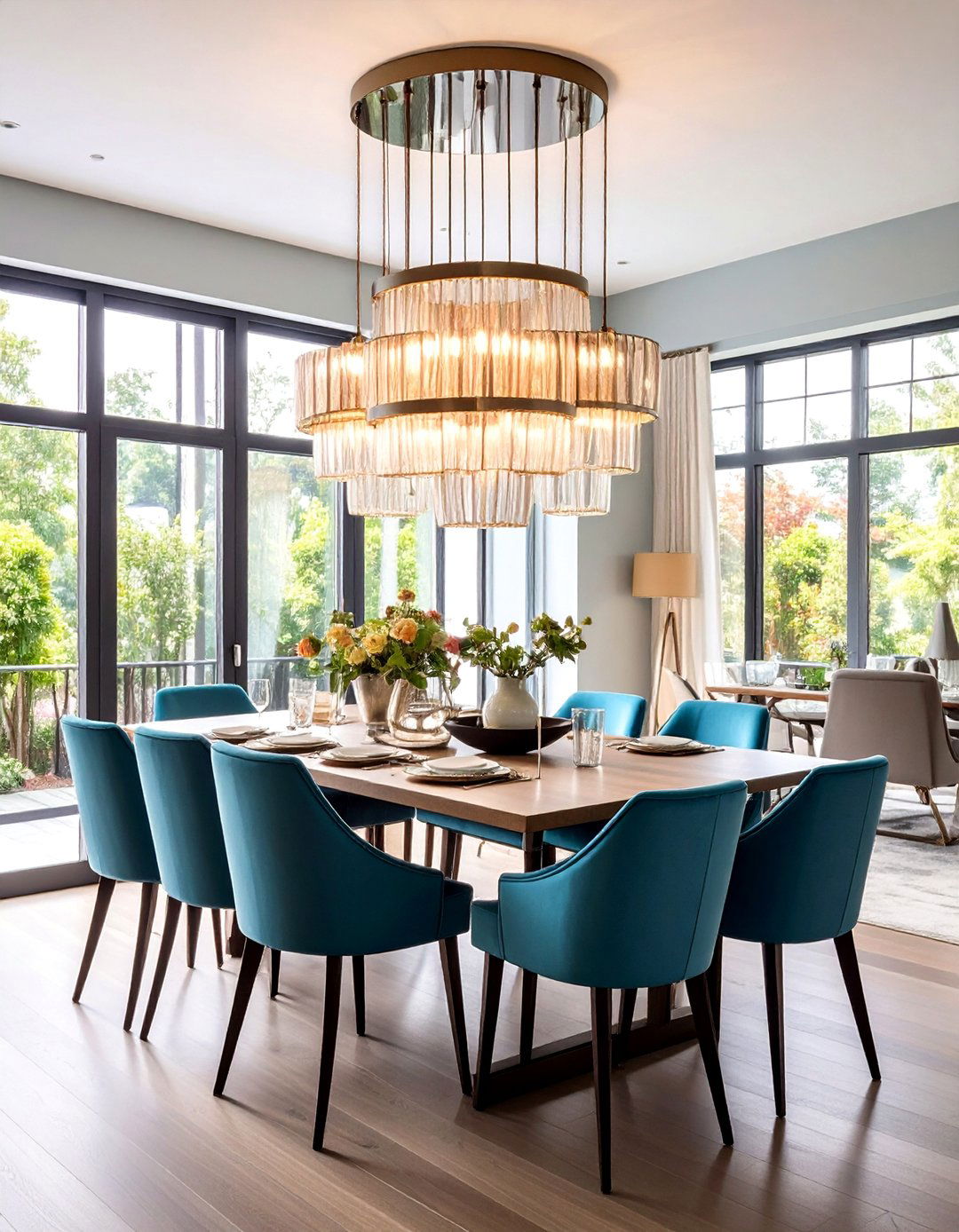
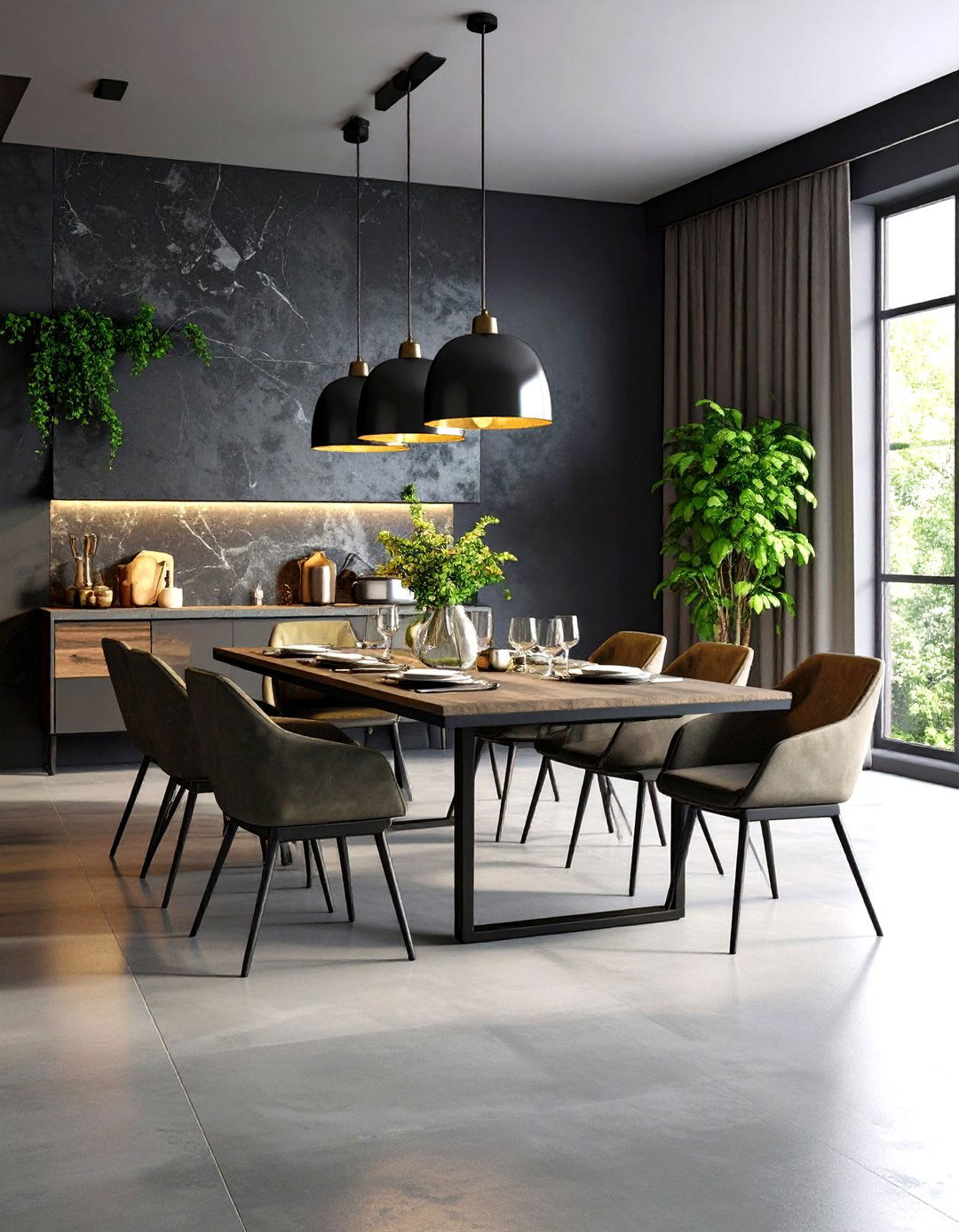
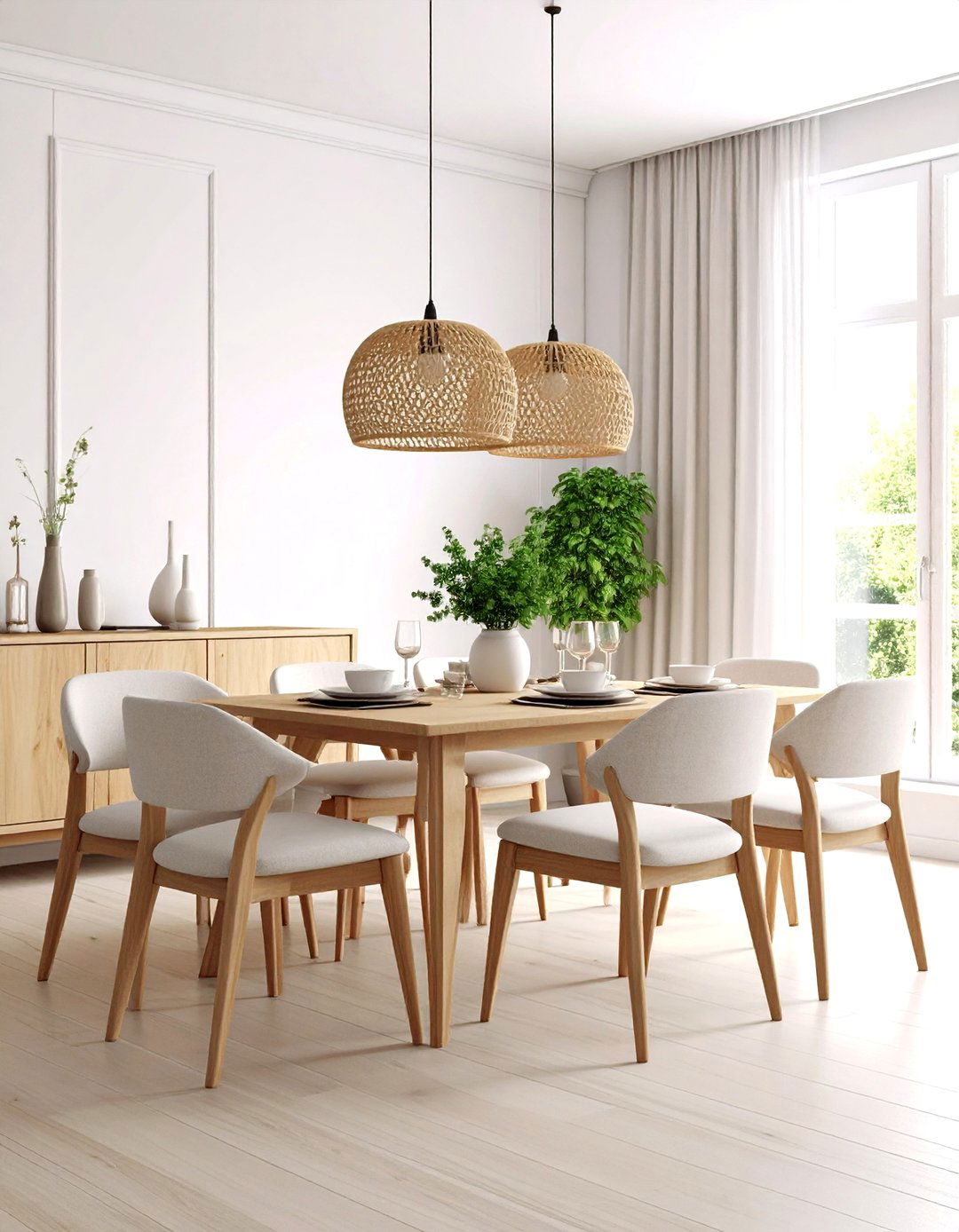
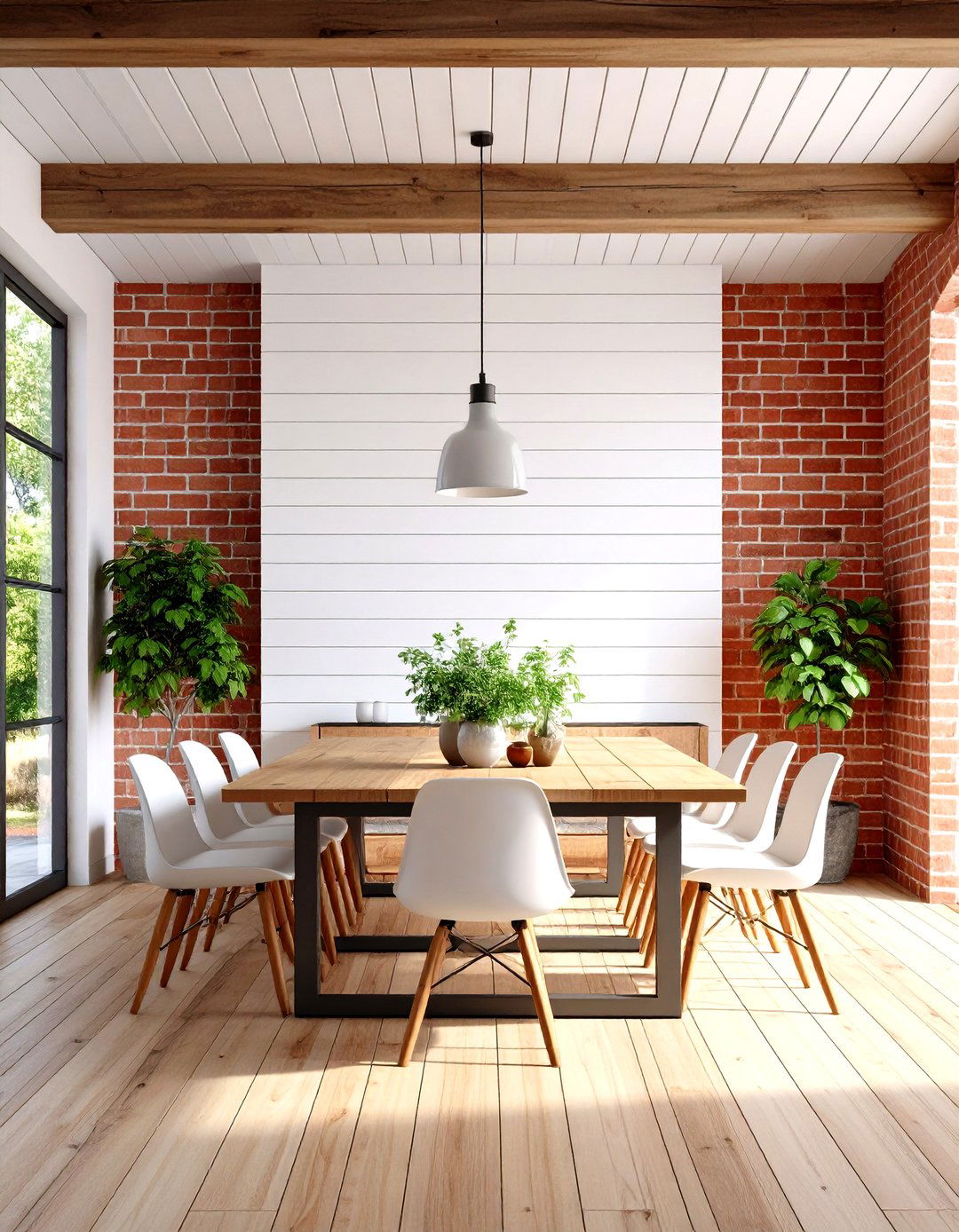
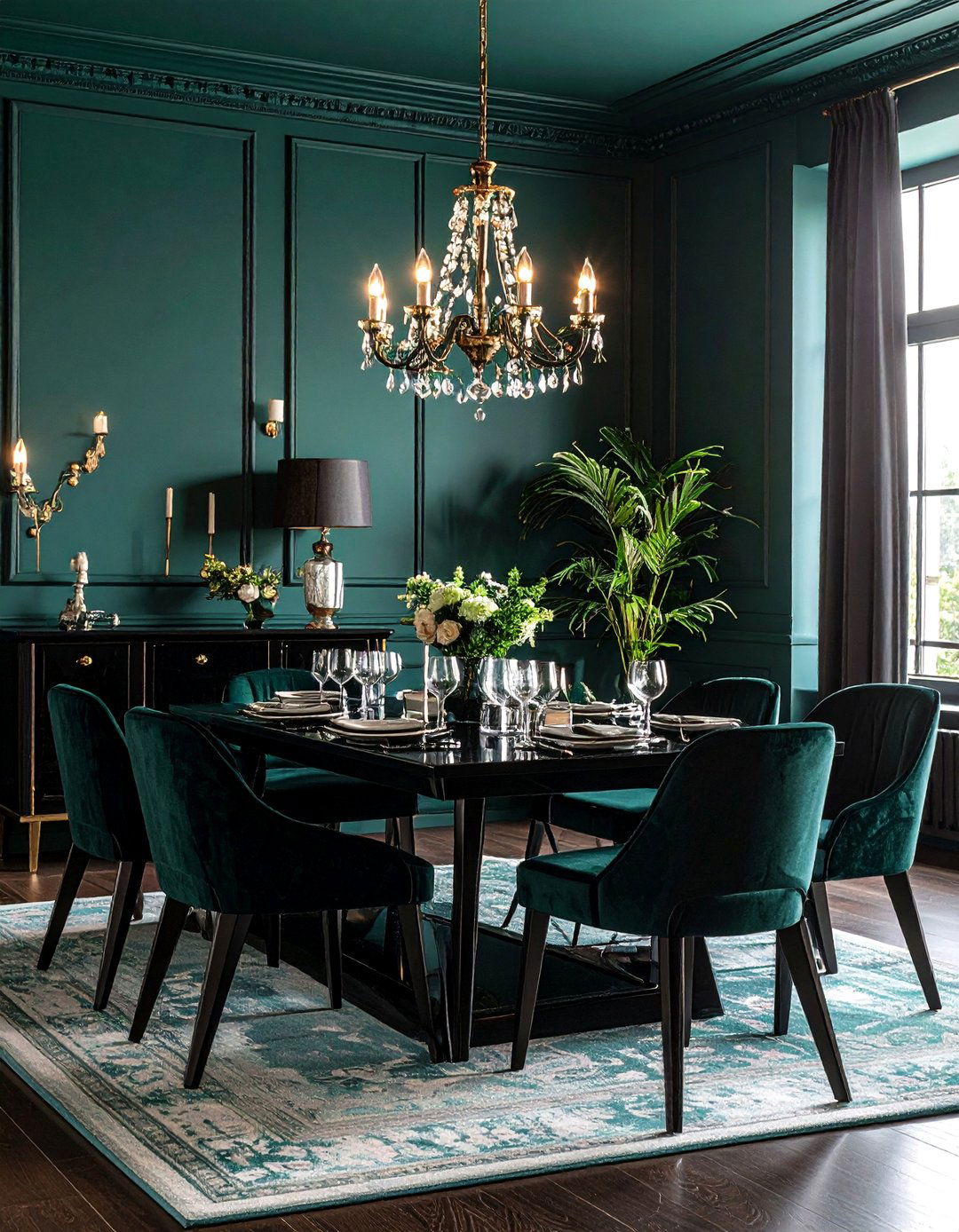
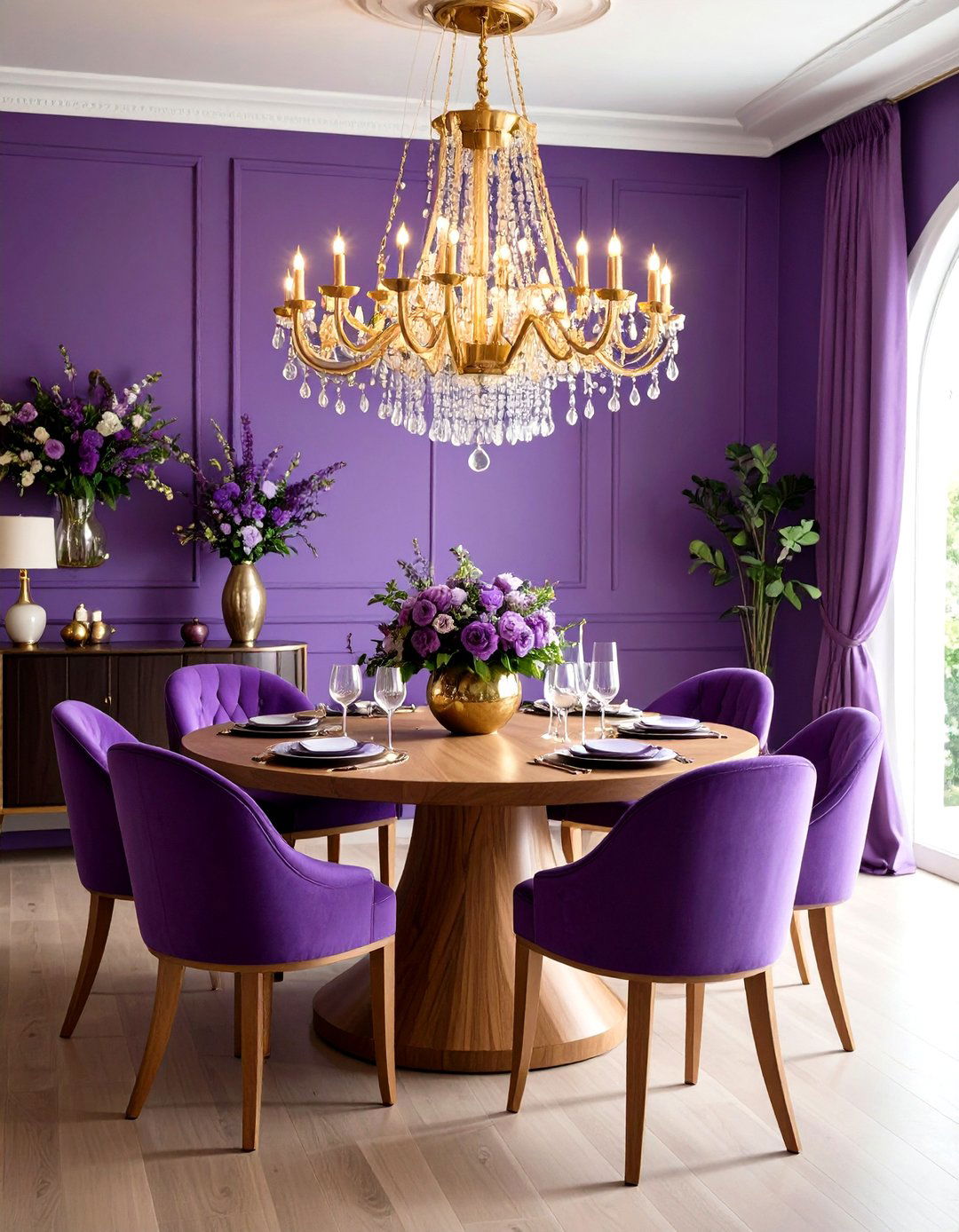
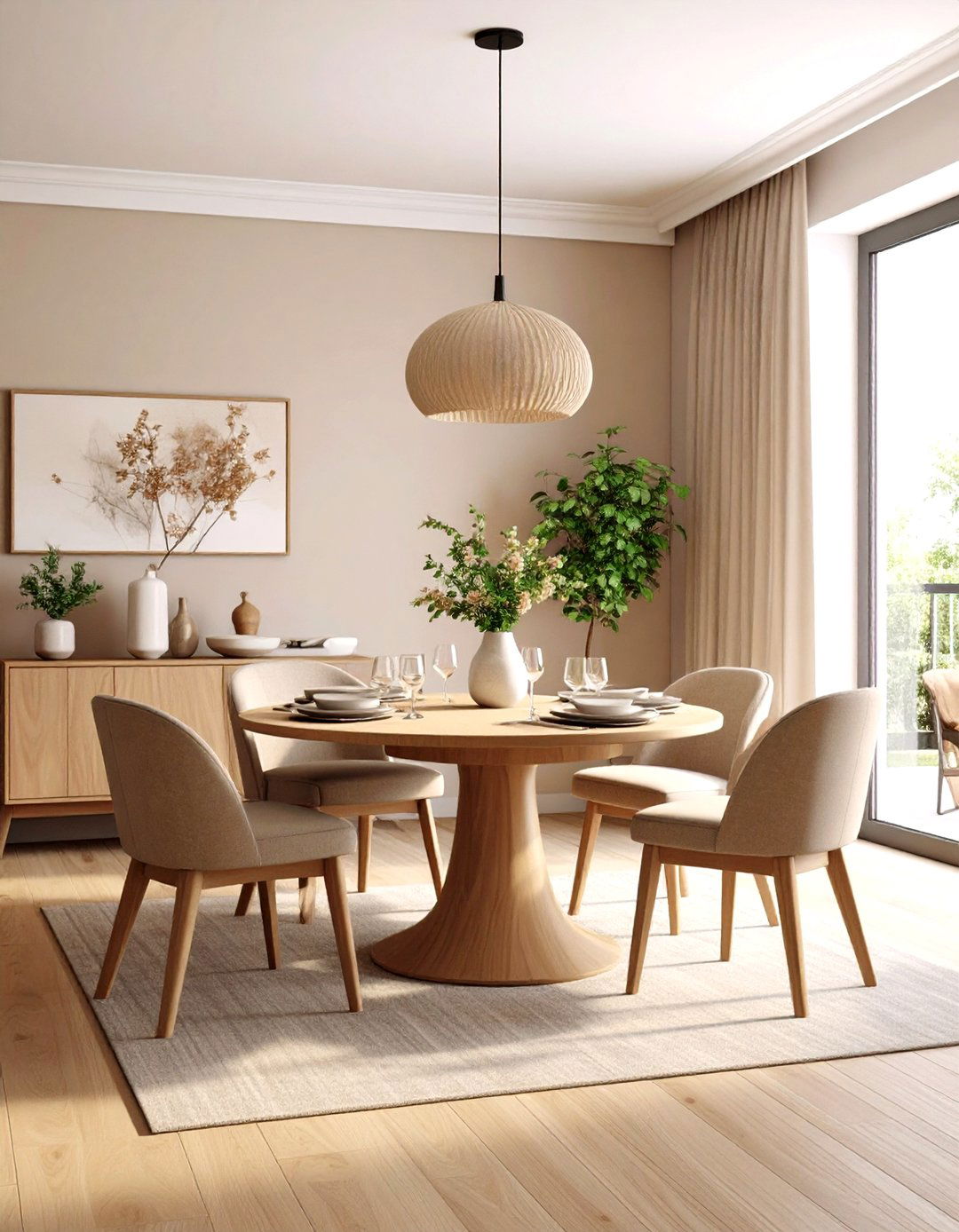
Leave a Reply